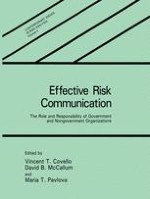One of the greatest challenges facing those concerned with health and environmental risks is how to carry on a useful public dialogue on these subjects. In a democracy, it is the public that ultimately makes the key decisions on how these risks will be controlled. The stakes are too high for us not to do our very best. The importance of this subject is what led the Task Force on Environmental Cancer and Heart and Lung Disease to establish an Interagency Group on Public Education and Communication. This volume captures the essence of the "Workshop on the Role of Government in Health Risk Communication and Public Education" held in January 1987. It also includes some valuable appendixes with practical guides to risk communication. As such, it is an important building block in the effort to improve our collective ability to carry on this critical public dialogue. Lee M. Thomas Administrator, U. S. Environmental Protection Agency, and Chairman, The Task Force on Environmental Cancer and Heart and Lung Disease Preface The Task Force on Environmental Cancer and Heart and Lung Disease is an interagency group established by the Clean Air Act Amendments of 1977 (P.L. 95-95). Congress mandated the Task Force to recommend research to determine the relationship between environmental pollutants and human disease and to recommend research aimed at reduc ing the incidence of environment-related disease. The Task Force's Project Group on Public Education and Communication focuses on education as a means of reducing or preventing disease.
